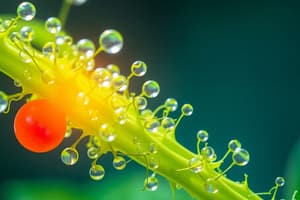Podcast
Questions and Answers
What is the primary function of leucoplasts in plant cells, and what types of compounds do they store?
What is the primary function of leucoplasts in plant cells, and what types of compounds do they store?
The primary function of leucoplasts is storage, and they store starch, lipids, and proteins.
What is the characteristic that distinguishes chromoplasts from other types of plastids, and what is their primary function?
What is the characteristic that distinguishes chromoplasts from other types of plastids, and what is their primary function?
Chromoplasts contain pigments responsible for yellow, orange, and red colors, and their primary function is the synthesis and storage of pigments.
What is the structure that surrounds chloroplasts, and what is its significance in photosynthesis?
What is the structure that surrounds chloroplasts, and what is its significance in photosynthesis?
The double membrane structure surrounds chloroplasts, and it is significant because it separates the internal chloroplast compartment from the cytosol, allowing for the regulation of chemical reactions and the exchange of molecules.
What is the site of light-dependent reactions in chloroplasts, and what is the role of this component?
What is the site of light-dependent reactions in chloroplasts, and what is the role of this component?
What is the primary function of amyloplasts, and in which type of tissue are they typically found?
What is the primary function of amyloplasts, and in which type of tissue are they typically found?
What is the pigment responsible for the red color of tomatoes, and in which type of plastid is it found?
What is the pigment responsible for the red color of tomatoes, and in which type of plastid is it found?
What is the role of lamellae in chloroplasts, and how do they relate to the functioning of thylakoids?
What is the role of lamellae in chloroplasts, and how do they relate to the functioning of thylakoids?
Flashcards are hidden until you start studying
Study Notes
Plastids
Plastids are organelles found in plant cells and some algae, responsible for various functions such as photosynthesis, storage, and pigment synthesis.
Leucoplasts
- Function: Storage of starch, lipids, and proteins
- Characteristics:
- Non-pigmented
- Found in non-photosynthetic tissues (e.g., roots, tubers)
- Can differentiate into chloroplasts when exposed to light
- Types:
- Amyloplasts: store starch
- Elaioplasts: store lipids
- Proteinoplasts: store proteins
Chromoplasts
- Function: Synthesis and storage of pigments (e.g., carotenoids, anthocyanins)
- Characteristics:
- Contain pigments responsible for yellow, orange, and red colors
- Found in fruit, flowers, and roots
- Can differentiate from chloroplasts or other plastids
- Examples:
- Tomatoes (lycopene)
- Carrots (carotene)
- Flowers (anthocyanins)
Chloroplasts
- Function: Photosynthesis
- Characteristics:
- Contain the pigment chlorophyll
- Found in photosynthetic tissues (e.g., leaves)
- Have a double membrane structure
- Components:
- Thylakoids: site of light-dependent reactions
- Stroma: site of light-independent reactions (Calvin cycle)
- Lamellae: inner membrane structure
Studying That Suits You
Use AI to generate personalized quizzes and flashcards to suit your learning preferences.




